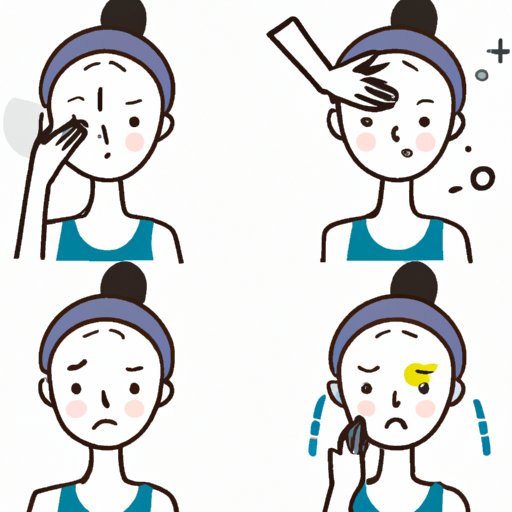Introduction
Acne is a skin condition that affects millions of people worldwide. It’s characterized by red bumps, whiteheads, and blackheads. Exercise is an important part of a healthy lifestyle, but can it make acne worse? In this article, we’ll explore the link between working out and acne, and provide tips for managing breakouts caused by exercise.
Exploring the Link Between Exercise and Acne
Exercise can be beneficial for your skin in many ways. Regular physical activity helps increase blood flow, which can bring oxygen and nutrients to your skin cells. This helps promote healthy cell turnover and can help reduce the appearance of wrinkles and other signs of aging.
However, there is also a potential downside to working out. Sweat and friction from clothing can clog pores and lead to breakouts. Additionally, some people may experience a surge in stress hormones when they exercise, which can cause inflammation and trigger breakouts.
Does Sweat Cause Acne?
Sweating itself does not cause acne. However, sweat can mix with dirt and bacteria on your skin, leading to clogged pores and breakouts. According to research published in The Journal of Clinical and Aesthetic Dermatology, this type of “follicular occlusion acne” is most common on areas of the body that are prone to sweating, such as the chest, back, and shoulders.
Is Working Out Making Your Acne Worse?
It’s possible that exercise could be making your acne worse. According to a study published in the International Journal of Women’s Dermatology, physical activity was found to be a risk factor for acne in adult women. However, this doesn’t mean that you should avoid exercise altogether. With the right precautions, you can still enjoy the benefits of physical activity while minimizing the risks of breakouts.

A Look at the Pros and Cons of Exercising with Acne
While exercise can potentially worsen acne, it can also be beneficial. Physical activity can help reduce stress, which can be a major trigger for breakouts. Additionally, regular physical activity can help improve circulation, which can help bring oxygen and nutrients to your skin cells. This can help reduce inflammation and promote healthy cell turnover.
The Effects of Exercise on Acne-Prone Skin
If you have acne-prone skin, it’s important to take extra precautions when exercising. Wearing breathable fabrics and avoiding tight clothing can help reduce friction and sweat buildup. Additionally, it’s important to cleanse your skin immediately after exercising to remove any sweat, dirt, and bacteria that may be lingering on your skin.
Are You Overworking Out? How to Tell If Exercise Is Causing Acne
If you’re experiencing breakouts after exercising, it’s important to pay attention to how often you’re working out. According to research published in the British Journal of Dermatology, excessive exercise can increase the risk of acne. It’s important to find a balance between physical activity and rest to give your skin time to recover.
If you’re experiencing frequent breakouts after exercising, it’s also important to look at your diet. Eating a balanced diet rich in whole foods can help nourish your skin and reduce inflammation. Additionally, it’s important to stay hydrated to keep your skin healthy and supple.
Finally, it’s essential to use the right skincare products. Cleansers and moisturizers designed for acne-prone skin can help manage breakouts and reduce inflammation. Using products with natural ingredients like tea tree oil and aloe vera can also help soothe irritation and promote healing.
Conclusion
In conclusion, exercise can be beneficial for your skin in many ways, but it can also potentially worsen acne. Sweat and friction from clothing can clog pores, and a surge in stress hormones can trigger breakouts. To minimize the risk of breakouts related to exercise, it’s important to wear breathable fabrics, cleanse your skin immediately after exercising, and use the right skincare products. Additionally, it’s important to find a balance between physical activity and rest to give your skin time to recover.
(Note: Is this article not meeting your expectations? Do you have knowledge or insights to share? Unlock new opportunities and expand your reach by joining our authors team. Click Registration to join us and share your expertise with our readers.)
